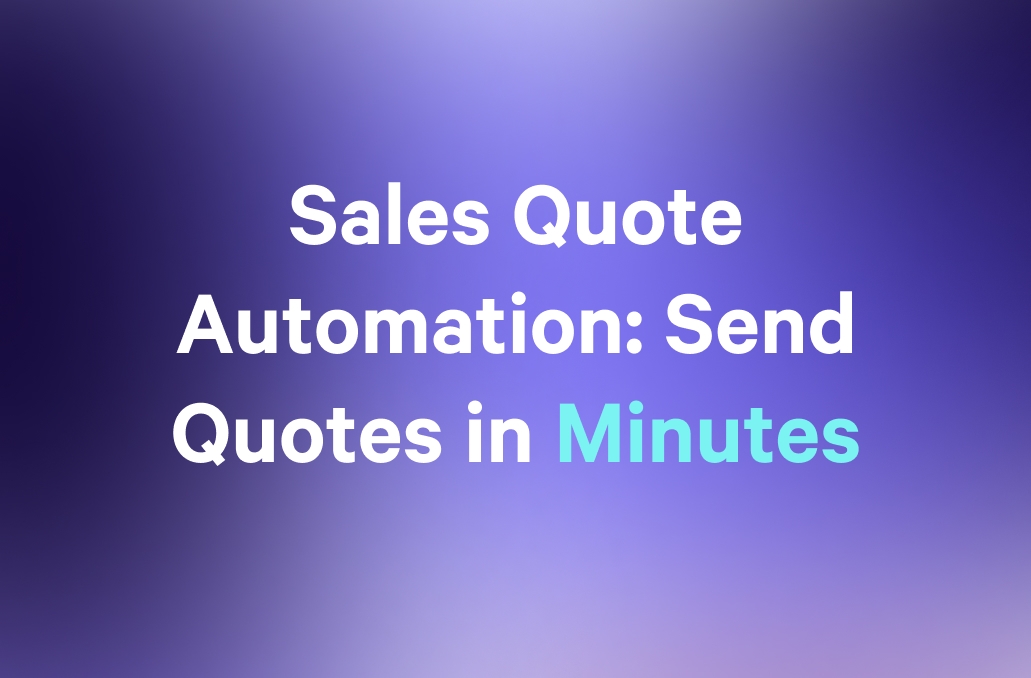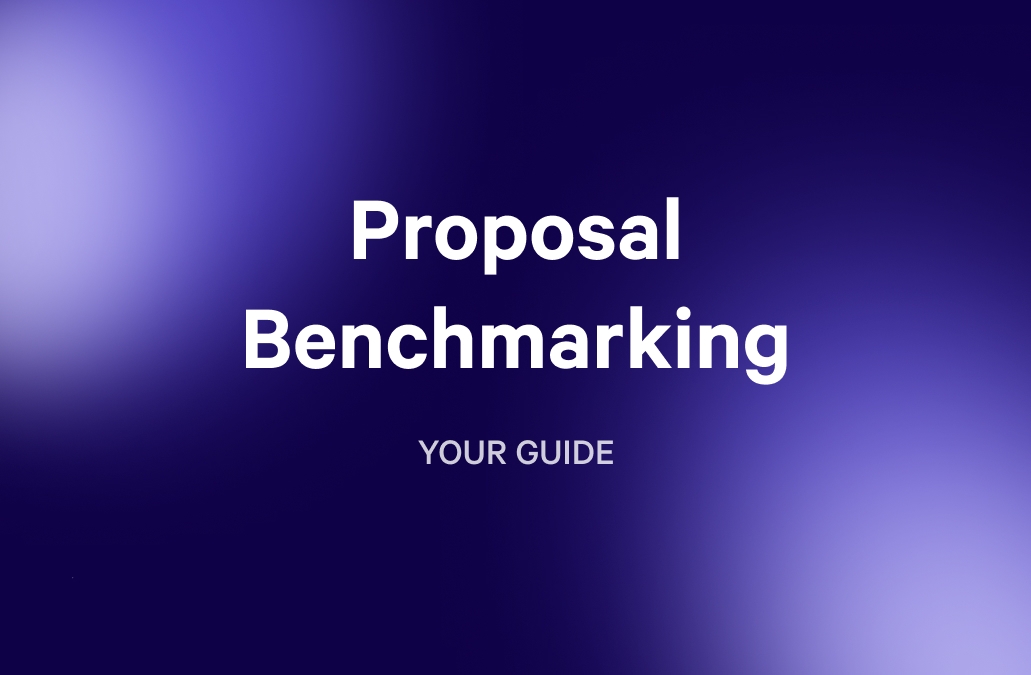Maybe you’ve felt this:
You send the proposal. Momentum dies.
You follow up and hear, “I just need to run it by my manager.”
Then... silence.
A week passes. The deal’s cold. And you’re left guessing what happened.
Here’s the truth most teams know but rarely talk about: You’re not just selling to one buyer anymore.
You’re selling to a finance lead, a technical stakeholder, a legal approver, and probably a few people you’ll never even meet. And yet… Most sales teams are still sending static, single-threaded proposals, then wondering why deals stall.
We call it the black box: you send something static, and from that point on, you’re blind. You can’t see who’s viewing it, what they’re focusing on, or how they’re reacting. In an era of longer deal cycles, more complexity, and more internal approvals, that’s a major liability.
Our team set out to understand what actually moves modern deals forward. So we analyzed 1,064,667 proposals — across thousands of live sales cycles — to find out what gets accepted, what gets ignored, and what consistently closes faster.
TL;DR: What’s in your proposal matters. But so does how it’s shared, used, and interacted with.
Let’s get into it.
What’s really killing your close rate?
Sales leaders often focus on the wrong moment in the deal cycle. They dissect discovery calls, fine-tune demos, or rework objection handling, but overlook one of the most influential (and fragile) stages of all—the proposal.
The proposal is where everything should come together. The business case, the ROI, the path forward—all wrapped in a format that helps the buyer move from interest to action. But for too many teams, it’s still treated as an administrative task. A static PDF, a Word doc, or a slightly repurposed deck.And it’s costing them.
In most cases, static proposals don’t actually help buyers make decisions — they make it harder. They’re long, generic, and hard to navigate. They don’t reflect the unique conversations that shaped the deal. They don’t answer the questions other stakeholders might have. And they give zero visibility into how the buyer engages — or if they engage at all.
The real issue isn’t just that proposals are static — it’s that they extend the black box. You don’t know if it’s been opened, who’s seen it, which section raised concerns, or whether it’s stalled in legal review.
And while you’re guessing, your buyer is doing the hard work of internal selling, usually without the tools or context to do it well. The burden shifts onto them to advocate for your solution, translate the value, and navigate approvals. That’s a lot to ask of someone who isn’t even paid to sell your product.
But the problem doesn’t end with visibility. It’s also about engagement. Today’s buyers are busy, distracted, and navigating layers of internal red tape. If your proposal doesn’t guide the decision-making process — if it doesn’t answer the unasked questions, speak to multiple stakeholders, and reinforce value clearly — it becomes one more document in a crowded inbox.
And this is precisely where deals go to die.
We see it all the time: strong sales conversations that stall at the proposal stage. Not because the buyer isn’t interested, but because the format doesn’t help them move forward. The proposal lacks context. It lacks clarity. It assumes your internal champion knows how to resell your solution to the rest of the team, which they usually don’t.
Meanwhile, high-performing teams are taking a different approach.
They’re not sending static summaries. They’re building interactive, buyer-first proposals designed to do the selling internally. Proposals that embed ROI calculators, show exactly how the solution aligns to the buyer’s goals, and can be passed around without losing context. They’re removing friction, not adding it. And they’re winning because of it (more on that later in the article).
What 1M proposals taught us about buyer behavior
With this study, we didn’t set out to prove a point. We set out to understand something that kept coming up in sales conversations, in feedback from customers, and frankly, in our own frustration: Why do some proposals close, and others disappear into the void?The conventional wisdom on what makes a good proposal was all over the place. Make it shorter. Make it more visual. Keep it simple. Add more detail. Everyone had a theory, but no one had the data to back it up.
So we decided to dig into our own.
We analyzed over 1 million proposals across thousands of businesses, industries, and deal types. That gave us something most sales teams don’t have access to: scale, patterns, and behavioral signals from the proposal stage itself, not just what happened before or after it.
BUT, here’s the thing—we wanted to answer one big question: What are the measurable behaviors that actually predict whether a deal will close? So we dug in — not just to see what was working, but to uncover why.
Here’s what we learned.
The more time spent on the page, the more likely to accept
One of the first things we looked at was time-on-page. We assumed there’d be a correlation between engagement and outcome, but the scale of it caught us off guard.
Proposals that were viewed for more than 4 minutes had an acceptance rate of 41%.Those viewed for less than one minute? Just 3.5%.
That’s an 11x difference. Based purely on attention.
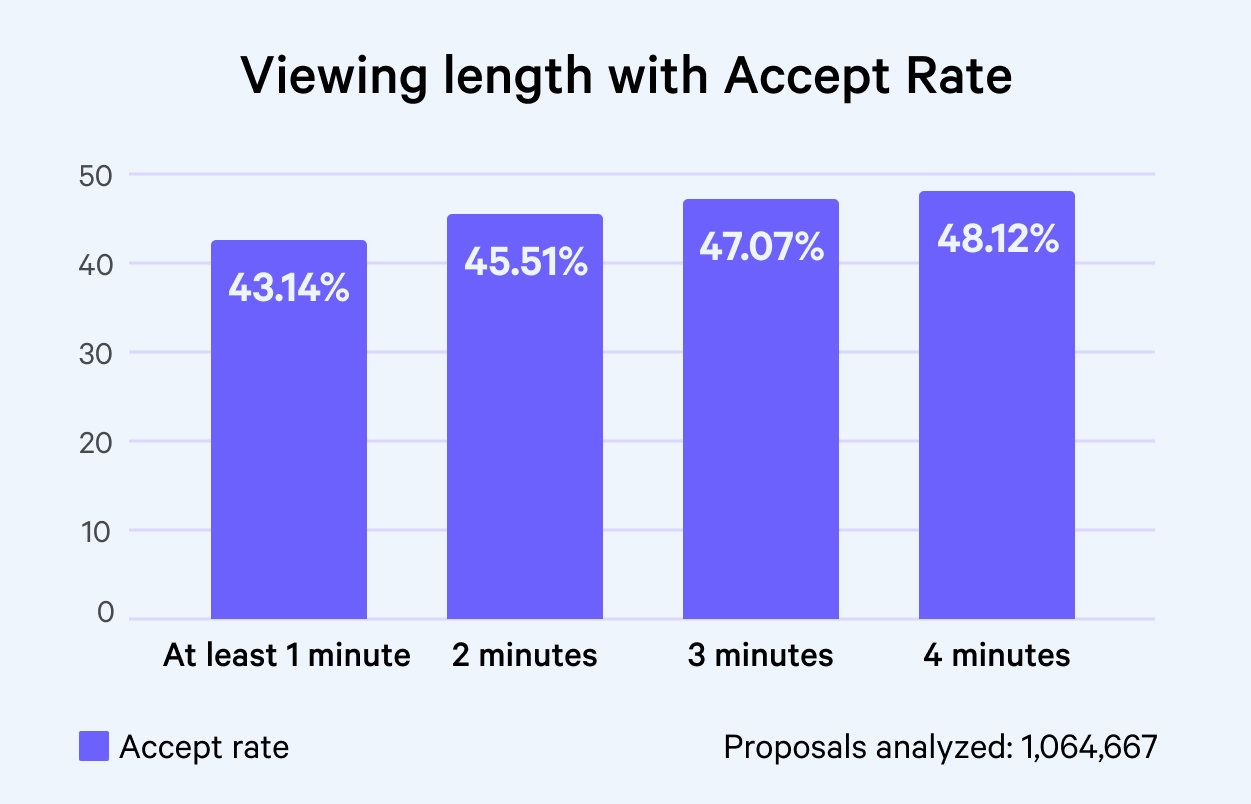
Now, time-on-page can be misleading if you're looking at a blog post or marketing asset. But in the context of a proposal, it’s an entirely different signal. No one reads a proposal for 4+ minutes unless they’re seriously evaluating it — not just glancing, but assessing, discussing, absorbing.
Think about what that means in practice: They might be comparing options. Re-reading terms. Thinking about how to pitch it to a colleague. Or looking at pricing with a decision-maker next to them.
Time spent = buyer intent. And more than that, it’s a proxy for confidence. Proposals that earn time tend to earn action!
It made us realise: if you're not designing your proposal to sustain engagement — to invite attention, not just survive it — you're likely losing deals you should be winning.
Proposals that get shared, get signed
Next, we looked at what happens when a proposal isn’t just opened, but shared.
Here, the data told a very clear story: when at least two additional unique users viewed a proposal within the first five days, the acceptance rate nearly doubled.

Why does this matter?
Because B2B buying is rarely a solo decision anymore, it involves the budget owner, the operations lead, the technical evaluator, legal, and likely someone who wasn’t in the original call at all.
What this data tells us is that multi-threaded engagement is predictive of deal velocity and success. It’s not enough for your champion to be excited — they need help selling the deal internally. And your proposal needs to do that work on your behalf.
The most successful teams aren’t relying on a PDF to float through an org and magically convert. They’re building proposals designed to travel well — self-contained sales tools that give context, show value, and work even when the rep isn’t there to present them.
It’s a different kind of enablement — not just internal, but buyer-side.
Interaction isn’t a design flourish — it’s a deal strategy
We also wanted to test something we’ve long believed, but hadn’t proven at scale: does interactivity actually impact outcomes?
We looked at proposals that included features like interactive pricing tables, embedded ROI calculators, videos, and clickable calendars — elements designed to make the proposal not just readable, but usable.
The result? Proposals with interactive elements saw acceptance rates up to 2x higher.
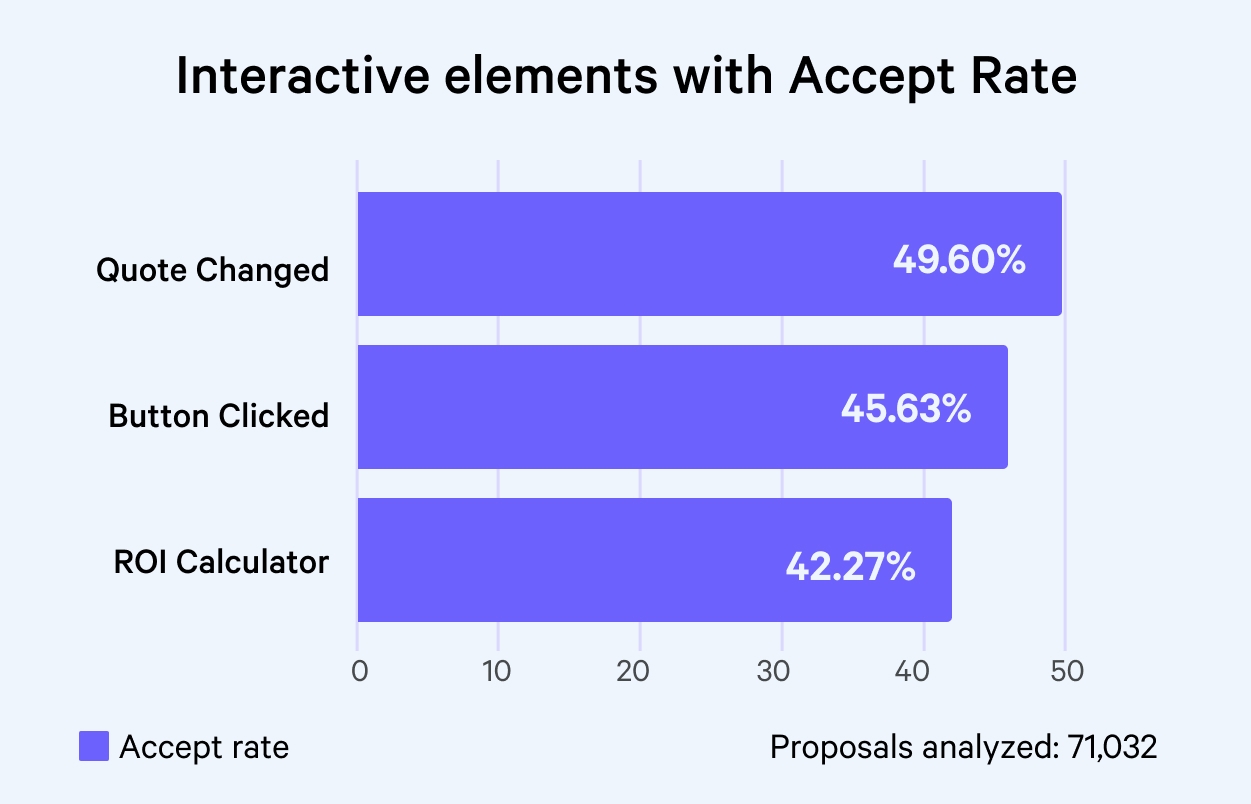
It’s easy to chalk this up to polish. Sure, buyers like something clean and well-designed. But when we looked closer, the most compelling reason for this boost was functionality.
Interactivity reduces cognitive load. It helps buyers answer questions without needing to email. It lets them model pricing scenarios before involving finance. It embeds value, not just lists it.
And most importantly, it shows you’ve anticipated their needs.
That’s what makes an interactive proposal powerful: not the bells and whistles, but the experience of clarity, speed, and forward motion it creates for the buyer.
Clarity trumps completeness
Finally, we turned to the most controversial variable: proposal length.
There’s a natural impulse to include everything. Every testimonial. Every case study. Every technical detail. After all, you don’t want to give prospects a reason to say “no.”
But the data told us otherwise.
Proposals with fewer than 6 content blocks (i.e. sections or pages) had a 66% higher conversion rate than anything longer.
Great sales teams don’t just simplify because it looks nice. They simplify because it helps buyers decide faster. They know that in the land of approvals, redlines, and internal forwarding, the clearest proposal usually wins.
Sydney Youngblood, Senior Account Executive, puts it like this:
“When your proposal is likely to be shared internally, a short personalised video can go a long way. It humanises the pitch and gives you a moment to frame the value in a way only you can. We’ve seen it reinforce clarity and trust, especially when you're not in the room.”
This clarity can also be reinforced visually: placing client logos, a strong testimonial, or a short proof point before and after the pricing block helps anchor the decision in credibility. It’s a subtle nudge that says: others trust us — you can too.
What this all tells us
After looking across 1 million proposals, here’s what we learned:
- Time spent matters. If your buyer stays engaged for more than 4 minutes, your win rate spikes 11x.
- Internal sharing matters. Proposals viewed by multiple stakeholders early are almost twice as likely to be accepted.
- Interactivity matters. Information toggles, ROI calculators, and dynamic pricing don’t just look good — they help close deals.
- Clarity matters. Shorter, focused proposals win. Every extra block should earn its place.
What surprised us wasn’t that these things worked — it was how consistently they showed up in winning deals. Across industries. Across team sizes. Across price points.
The new rules of proposal building — and how great teams actually use them
While analyzing the data, the patterns were hard to ignore. Certain behaviors — shorter structure, internal sharing, embedded interactivity — didn’t just look better. They consistently led to higher win rates.
But data alone isn’t the story. So, we turned to Qwilr customers and external industry experts who are already using interactive proposals to see how those insights played out in real deals. Their responses revealed something more valuable than opinion: a set of repeatable plays that innovative teams are using to reduce friction, speed up decisions, and make proposals work harder inside the deal.
Rule 1: Clarity closes
The data makes one thing clear: the shorter the proposal, the better your chances. That doesn’t mean being vague or oversimplified. It means stripping out noise and surfacing the essentials, so your buyer can say yes without scrolling through six pages of context.
"Gone are the days of lengthy proposals — everyone wants short and sharp and compelling."
Dara Fitzpatrick - Director of Sales - Forefront Events
Teams putting this into practice keep their proposals tight and navigable: a short summary, value breakdown, pricing, and next steps. Supporting detail (like technical specs or legal terms) is often tucked into expandable blocks or linked out to separate resources. The new mantra is “less but clearer”, states Mael Hartl, Head of Revops at Shippit, as he elaborates:
"Buyers are under more pressure and have less time, which means proposals need to be sharper, faster, and more tailored than ever. There’s now an expectation for concise, personalised, and outcomes-focused proposals that cut through the noise. Dense 50-page decks are out”.
Rule 2: Make your proposal shareable, not just readable
Your proposal isn’t just for your point of contact. It’s for the people they need to convince. High-performing teams design their proposals with this in mind. They add sections like “For Approval” or “What Your Execs Need to Know.”
They lead with clarity, anticipate objections, and give internal champions what they need to get the deal over the line, similar to what Ben Child’s team at Digital Reach does:
“We treat our proposals like decks now — something our champion can forward to finance or legal without needing us to re-explain everything. It does the selling for us.”
But there’s always room to improve the process, and that's what the team at HowdyGo swears by:
"Our proposal process is deliberately cross-functional to make sure we reflect the full strength of the business... This approach ensures every proposal is both commercially compelling and operationally sound."
Rule 3: Don’t bury the blockers
A hidden clause is a delayed conversation. The most effective teams don’t try to sneak contract terms past their buyers — they highlight them. That might mean bolding cancellation clauses. Calling out payment terms. Or clearly labeling things like notice periods and billing frequency.
It may seem risky, but the impact is the opposite: it builds trust and accelerates alignment. One Qwilr customer said they’ve eliminated last-minute surprises by simply surfacing terms earlier in the proposal.
“We put terms and conditions that are often negotiated on in bold... If we need to negotiate on it, we should do it now rather than hope the prospect skims over it only to be surprised when it’s enforced later.”
— Digital Reach
A pro recommendation from Sydney Youngblood, Senior Account Executive, who’s seen thousands of proposals land (or stall), is to use opt-out periods as a way to reduce buyer hesitation.
“I like using opt-out periods to reduce the risk of every customer’s fear… shelfware.”
By addressing risk early and transparently, you give buyers a reason to move forward, not hold back. It’s a small clause that signals flexibility and builds trust, especially in competitive or budget-conscious deals.
Rule 4: Treat proposal opens like buying signals
Real-time alerts — whether via Slack or email — give teams visibility into how a proposal is moving internally. That information can guide when (and how) to follow up. More advanced teams are even beginning to use engagement metrics to improve their proposal strategy in real-time.
"We track metrics like time spent in contract stages and stakeholder engagement, which help us see whether a proposal is progressing smoothly or stalling... For larger deals, we're considering a stakeholder coverage score—something to assess how well we’re addressing each decision-maker’s needs."
— Shippit
One customer shared how a mid-funnel proposal went cold, only to be reopened weeks later, leading to a well-timed follow-up that revived and closed the deal.
“A random view months down the line can be key to a reach-out... We've captured interest and restarted conversations into eventual deals.”
— Digital Reach
The takeaway? Don’t assume the deal is dead. Assume it’s moving — just not on your schedule. And when those signals fire, speed matters. Waiting too long after a prospect reopens a proposal can cost you momentum — and sometimes the deal. A fast, thoughtful follow-up via call or email immediately after the activity gives you the best chance of re-engaging their attention while it’s still fresh.

Rule 5: Align before you send
The most overlooked best practice in proposal creation happens before the proposal is even written. It’s the conversation that gets skipped when everyone’s rushing to keep the deal moving: confirming budget, authority, timeline, and actual appetite to buy.
As Mael puts it: “One that’s often missed is proper pre-proposal alignment — too many teams rush to send a deck without confirming key details like appetite, authority, or timing. It’s far more effective to qualify properly upfront.
This kind of alignment doesn’t require a complex framework — just a quick check-in to confirm: Is the buyer serious? Do they have budget? Are the right people involved? It’s a small step, but it can save hours of work and weeks of back-and-forth. (If you’re looking for structure, sales you can use quick frameworks like BANT or MEDDICC to guide this step.)
It’s especially useful in industries where pricing depends on scope (like consulting or software), where proposals include implementation plans (like logistics or operations), or where more than one person has to sign off (like in enterprise sales or partnerships).
For example: if you know a buyer’s legal team is deeply involved in procurement, you can surface commercial terms up front. If timing is fuzzy, you can gate the proposal behind a mutual action plan. And if budget is a wildcard, you can tailor the scope and ROI messaging accordingly — not cross your fingers and hope.
Rule 6: Show, don’t just tell
Buyers want clarity, fast, especially those who weren’t in the room when the pitch was delivered.
That’s why visuals matter. Proposals that embed live dashboards, videos, or ROI models make your message easier to grasp — and easier to share internally. It’s not about design for design’s sake. It’s about making your solution instantly legible to someone who might only glance at the page.
As Umberto Anderle, Cofounder at HowdyGo, puts it:
“We try to keep proposals as simple as possible. I feel like you should be able to quickly understand a proposal from a single page and not have to read through an endless PDF to catch the main points. We also aim to add demos and screenshots when discussing functionality for that same reason.”
But here’s the thing…
The best teams go a step further using interactive elements to do the heavy lifting. Instead of listing pricing options in a table, they let buyers toggle between packages. Instead of describing the implementation, they embed a 60-second walkthrough. Instead of sending a calendar link in a follow-up email, they include it right in the proposal.
Tools like Qwilr make this easy to scale. From reusable blocks and drag-and-drop layouts, to brand styling and embedded ROI calculators, teams can turn static proposals into polished sales collateral that feels more like a webpage than a document — one that informs, persuades, and converts
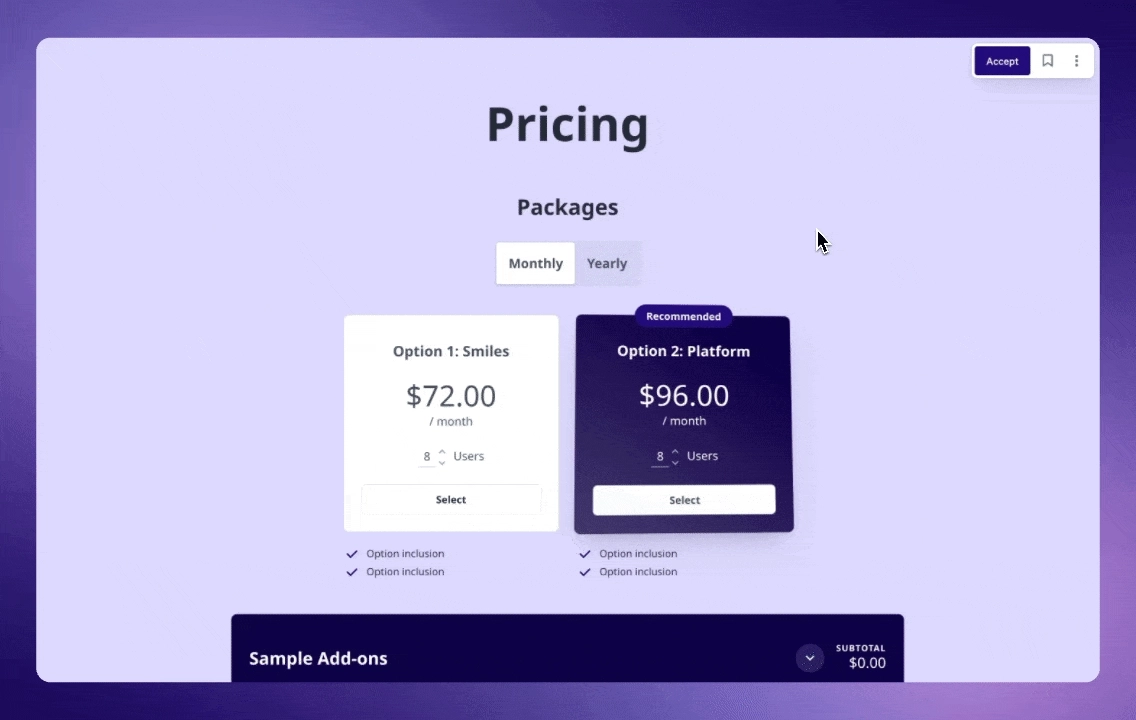
Why most proposals still stall (and how to fix it)
The best-performing teams approach their proposals with intent, shaping every section around how their buyer actually makes decisions. But many teams fall into familiar traps: shortcuts that feel efficient in the moment, but quietly slow down deals. These mistakes aren’t careless — they’re usually byproducts of speed, repetition, and old habits. The good news? They’re also fixable — often with small shifts that compound into major gains. Let’s look at them:
Using the same template for every deal
It’s easy to fall into the habit of recycling a single template, especially when deals are moving quickly. But while standardisation might help with speed, it rarely helps with conversion. Every buyer comes with a unique set of priorities, objections, and decision-makers. When your proposal doesn’t reflect that, it creates friction.
Buyers are left to interpret how your solution applies to them, or worse, they forward something generic to someone else internally. That’s when momentum stalls.
“Personalisation, but not the Hi {firstName} kind. It's about whether the proposal solves for the pain points uncovered during the discovery process. Does it use the customer's language & terminology when addressing their problems or is it copy/pasted from a template? Does it address each problem one by one with a strong solution?”
— HowdyGo
A better approach is to build modular content that can be tailored without starting from scratch each time. Identify your most common objections and create reusable blocks that speak directly to them, written in language that reflects how your customers talk about their problems.
Just as importantly, always anchor the proposal in what they need, not the standard product you offer. They don’t care about your internal features. They care about outcomes. Make it obvious how you're solving their problem.
This way, you preserve speed without sacrificing specificity, and create proposals that feel like they were built for the buyer, not about you.
Treating the proposal like a formality
For many teams, the proposal is positioned as a recap, a tidy summary of everything already discussed. But in doing so, the proposal becomes passive. It doesn’t move the deal forward; it waits for the buyer to do that. The most effective proposals behave differently. They carry momentum. They map the path to a decision. Including a “next steps” section is one small, powerful way to shift this dynamic. Show what happens after signing.
Add timeline clarity. Use that section to project confidence and reinforce that you’re ready to lead the process, not just conclude it.
If you’ve confirmed urgency in the sales process (“We need this live by July 1”), you can now use that in the proposal to guide follow-up. (“To meet your go-live goal, we’ll need to sign off by June 10.”)
This not only reinforces commitment, but it also gives you leverage if things go quiet.
Expecting the buyer to retell your pitch
You might have nailed the discovery call and delivered a strong narrative, but the moment your proposal gets forwarded, the story fragments. That’s because your champion isn’t equipped to tell it like you can.
They don’t have the same framing, the same urgency, or the same language. And yet, this internal retelling is often where deals are won or lost. The best proposals make this easy. They include a short, focused section like “Why now?” or “What this solves,” written in the buyer’s own language.
Keep the focus on value, but keep it concise. If your proposal is too dense or text-heavy, momentum stalls. The buyer walks away overwhelmed. Simplicity isn’t just aesthetic — it’s strategic.
This isn’t about restating your value — it’s about giving your champion a story they can run with.
Sending, then waiting
This is one of the most common and costly habits: sending the proposal, marking the task complete, and hoping to hear back. The problem is, without visibility, you have no sense of timing, interest, or movement.
And by the time you follow up, the buyer’s attention may already be gone. Top teams don’t wait. They track. They use real-time alerts to see when a proposal is opened or shared, and follow up while the conversation is still alive. Timing isn’t everything — but it’s often the difference between a buyer who’s leaning in and one who’s moved on.

Static proposals fade. Interactive ones convert
Before we wrap up, one final thought: small shifts in how you structure, frame, and deliver a proposal can have a disproportionate impact on outcomes, something we’ve seen in both in the data and in the field. It’s not about adding bells and whistles.
It’s about removing friction. Creating clarity. Building confidence — not just in your solution, but in the decision to move forward.
The teams getting this right aren’t necessarily writing more proposals. They’re writing smarter ones. Proposals that guide the decision, speak to people beyond the initial call, and make it easier to say yes. Proposals that don’t need to be explained — because they already make the case.
If you're still sending static proposals, you're likely putting your best deals at risk. Because in most sales cycles, it's not just what you pitch — it's what you send afterward that shapes the decision.
Want to see what that looks like? Book a demo today, and our team will show you how to build interactive proposals that are easy to create, designed to be shared, and built to close.
About the author

Jess Tassell|Fractional CMO
Jess is the Fractional CMO at Qwilr, looking after product marketing, growth, content functions and more. Prior to Qwilr, Jess was the International CMO of StubHub International (eBay owned $5B marketplace), where she led a team of 44 marketers across 69 markets. Jess also has extensive strategy consulting experience in Australia and the United States from starting her career at EY.

